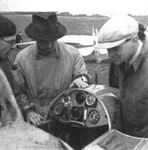
M.Simons The World's Vintage Sailplanes 1908-45
THE VIKING
In 1937 Hans Zander and Roy Scott set up a new business in England and in 1938 Scott’s Viking sailplane was advertised. Scott avoided expensive features like ‘gull’ wing dihedral. The wing root required no detachable fairings, the Viking's wings being attached by a vertical steel expanding bolt inserted and tightened from above. A strong ‘carry through’ structure was built into the main fuselage frame. The small pin at the rear attachment point was also inserted from above. Rigging was easy. The ailerons were automatically linked when the wings were attached.
The ailerons themselves were differentially geared. Instead of the usual central hinge line with round plywood tube aileron spar, the Viking’s hinges were located on the top wing surface, perhaps not so efficient aerodynamically, but cheaper to make and easier to dismantle for maintenance. By means of a ratchet lever in the cockpit, the ailerons could be trimmed up or down together to act as camber flaps.
The aerofoil was Goettingen 535 whilst the tail unit was somewhat like that of the Minimoa, the tailplane being carried on a sub fin, lifting it well clear of the ground. A skid was 166 provided for landing, and the seat had space for a ‘back type’ parachute. Performance claims were moderate with a best glide ratio about 1 : 20 and minimum sinking speed of 0.76 m/sec.
The Viking was test flown at Dunstable in November 1938. The prototype was sold and exported to the Argentine where it broke several local records. Three more Vikings were built. The only one to survive the war was flown at Camphill by George Thompson to 4721 metres after a bungee launch into a 70-knot wind. This was one of the first high wave flights made in Britain, and Thompson followed this with another similar ascent a few weeks later. This Viking was still flying in 1980.
Scott designed and built a two-seat Viking 2 of 18.6 metres span, with side-by-side seating. This was flown in 1939 and survived for some years until, when it was being test flown at Farnborough, it developed severe flutter, broke up and crashed. The pilots smartly evacuated by parachute.
Technical data:
Viking: Span, 15.54 m. Wing area, 15.89 sqm. Aspect ratio. 15.2. Empty weight, 167.83 kg. Flying weight, 244.94 kg. Wing loading. 15.38 kg/sq m. Aerofoil, Goettingen 535 at the root with symmetrical tip.
- M.Simons The World's Vintage Sailplanes 1908-45
Фотографии
-
GL / M.Simons - The World's Vintage Sailplanes 1908-45 /Kookaburra/
The Scott Viking, restored by Lou Glover, and normally based at Husbands Bosworth. The finish had been partly returned to the original clear doped and varnished style.
-
Aeroplane Monthly 1997-03 / D.Webb - Silent warriors /Tested & failed/
The Scott Viking I in flight circa 1938-39.
-
GL / M.Simons - The World's Vintage Sailplanes 1908-45 /Kookaburra/
Регистрационный номер: BGA416 [2], G-ALRD [2] The Scott Viking at Camphill in 1948. At this time it was still in its original factory finish of clear dope and varnish. The registration letters were added in vermilion but were removed as soon as revised regulations permitted. The Viking still flies.
-
Aeroplane Monthly 1997-03 / D.Webb - Silent warriors /Tested & failed/
Регистрационный номер: BGA416 [2], G-ALRD [2] Viking BGA416/G-ALRD at the 1994 VGC rally at Lanham.
-
Flight 1939-07 / Flight
The new Viking, showing wing section (Gottingen 535) - E. J. Furlong (pilot) on far side of nose.
-
Flight 1939-07 / Flight
Instrument panel of the Viking. The thin white upright object is the variometer, or climb-and-fall indicator
- Фотографии






